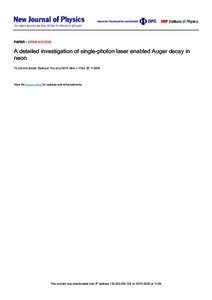A detailed investigation of single-photon laser enabled Auger decay in neon
Giulio Gaio; Michele Di Fraia; Najmeh Mirian; Simone Spampinati; Primož Rebernik Ribič; Harshitha N G; Laura Badano; Daehyun You; Mauro Trovò; Carlo Spezzani; Paolo Antonio Carpeggiani; Oksana Plekan; Lénárd Gulyás Oldal; Bruno Diviacco; Marco Ruberti; Giuseppe Sansone; Simone Di Mitri; Praveen Kumar Maroju; Carlo Callegari; Kuno Kooser; Tamás Csizmadia; Giovanni De Ninno; Kiyoshi Ueda; Enrico Allaria; Kenichi L Ishikawa; Giuseppe Penco; Kevin C Prince; Luca Giannessi; David Gauthier
A detailed investigation of single-photon laser enabled Auger decay in neon
Giulio Gaio
Michele Di Fraia
Najmeh Mirian
Simone Spampinati
Primož Rebernik Ribič
Harshitha N G
Laura Badano
Daehyun You
Mauro Trovò
Carlo Spezzani
Paolo Antonio Carpeggiani
Oksana Plekan
Lénárd Gulyás Oldal
Bruno Diviacco
Marco Ruberti
Giuseppe Sansone
Simone Di Mitri
Praveen Kumar Maroju
Carlo Callegari
Kuno Kooser
Tamás Csizmadia
Giovanni De Ninno
Kiyoshi Ueda
Enrico Allaria
Kenichi L Ishikawa
Giuseppe Penco
Kevin C Prince
Luca Giannessi
David Gauthier
IOP PUBLISHING LTD
Julkaisun pysyvä osoite on:
https://urn.fi/URN:NBN:fi-fe2021042825732
https://urn.fi/URN:NBN:fi-fe2021042825732
Tiivistelmä
Single-photon laser enabled Auger decay (spLEAD) is an electronic de-excitation process which was recently predicted and observed in Ne. We have investigated it using bichromatic phase-locked free electron laser radiation and extensive angle-resolved photoelectron measurements, supported by a detailed theoretical model. We first used separately the fundamental wavelength resonant with the Ne+ 2s?2p transition, 46.17 nm, and its second harmonic, 23.08 nm, then their phase-locked bichromatic combination. In the latter case the phase difference between the two wavelengths was scanned, and interference effects were observed, confirming that the spLEAD process was occurring. The detailed theoretical model we developed qualitatively predicts all observations: branching ratios between the final Auger states, their amplitudes of oscillation as a function of phase, the phase lag between the oscillations of different final states, and partial cancellation of the oscillations under certain conditions.
Kokoelmat
- Rinnakkaistallenteet [19218]
